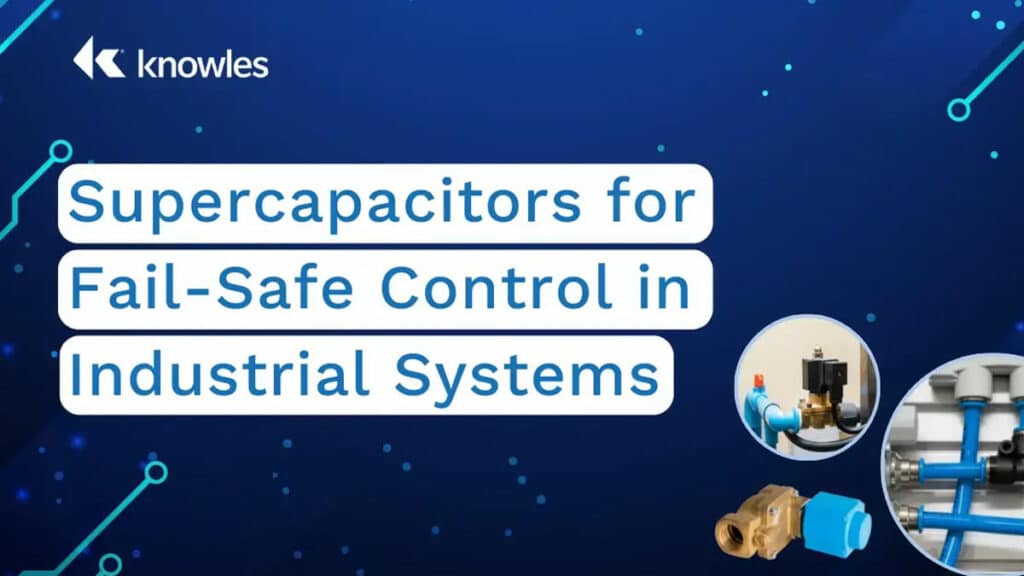This article based on Knowles Precision Devices blog is demonstrating benefits of supercapacitors in fail-safe valve control industrial systems.
Unplanned power interruptions and shutdowns pose significant risks to industrial facilities.
Even a brief loss of control can lead to equipment damage, safety hazards, or production losses. In high-stakes industrial environments, fail-safe systems are crucial risk mitigation techniques.
Engineers are increasingly turning to supercapacitors for reliable and precise energy delivery in automated valve control systems. This shift is particularly relevant in applications where traditional batteries or spring-return mechanisms are less practical, as supercapacitors offer greater resilience and safety.
Using Supercapacitors for Automated Valve Actuation
Supercapacitors store energy electrostatically, enabling rapid charge/discharge cycles that support high-power delivery and quick energy recovery in short bursts. In the context of a valve control system, supercapacitors continuously charge from the main power supply during normal operation. If a power failure occurs, the stored energy drives the actuator motor to move valves to a predefined, safe position. Advanced energy management systems leverage algorithms to optimize charging patterns and prevent deep discharge, which can lead to accelerated wear, reduced efficiency, and potential failures.
Electronic valve control systems have historically relied on traditional battery or spring-based fail-safe mechanisms. However, supercapacitors offer a more reliable, maintenance-free alternative with a longer lifespan compared to lithium batteries, often lasting up to 10 years. They also maintain efficient operation in extreme temperatures, charge fully in seconds instead of hours, and don’t experience degradation from partial charging.
Switching from mechanical springs to supercapacitors eliminates opportunities for mechanical wear and allows for smaller actuator designs. Supercapacitors also provide greater consistency, enabling the programming of fail-safe positions and consistent torque values. This makes them uniquely beneficial for remote or hard-to-access installations.
Supercapacitors offer potential drawbacks, especially for those with tight budgets. While they excel at quickly reaching a safe position, traditional batteries may be necessary for sustained operation during long outages. Additionally, the team will need to dedicate time and attention to precise energy calculations in mission-critical industrial applications.
Practical Applications for Supercapacitor-Based Fail-Safe Systems
Supercapacitor-based fail-safe systems have practical applications in various industrial functions. In HVAC systems, they enable automated safety responses during power outages, such as closing steam valves or opening ventilation dampers. In industrial process control, they can drive actuators that safely shut off oil or gas flow in pipelines. Refrigeration plants also benefit from this technology, where supercapacitor-backed controls help protect compressors from liquid slugging, a common cause of damage. Furthermore, they are essential in high-stakes environments like nuclear facilities and chemical plants, where any failure in control systems could have severe consequences.
To successfully implement supercapacitor-based systems, engineers must consider key technical specifications. Energy storage sizing is crucial. For instance, consider an industrial oil- and gas-flow example from Analog Devices. In this system, there’s a bank of 10 supercapacitors rated at 3400F and 2.7V connected in series. In the event of a power failure, the supercapacitor bank can power a 10A load with approximately 330 seconds of backup energy, allowing the actuator to move to its emergency position. This example highlights the importance of determining the required power to ensure safe positioning of valves or other end devices during an outage.
Proper power management is essential when configuring supercapacitors in series. Voltage balancing circuits are crucial to prevent cell overvoltage and extend system life. Once implemented, integrated modules can streamline deployment by offering system health monitoring and diagnostic features that simplify long-term maintenance.
Supercapacitors, despite requiring upfront design considerations and energy planning, offer compelling benefits, especially for remote or mission-critical applications. These benefits include improved operational uptime, enhanced actuator performance, and reduced maintenance.
